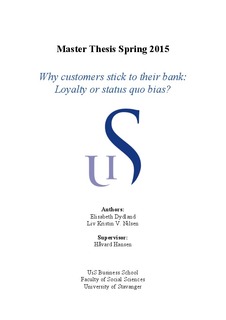| dc.description.abstract | The question concerning how individuals make decisions is of crucial interest to researchers. The purpose of this thesis is to detect how loyalty and status quo bias affects customers’ intention to stay with their current provider. To be able to reveal the presence of these effects, the theoretical model developed was constructed to capture customers’ intention to stay with their current bank. It was desirable to choose a lost-for-good type of service, where commitment is relatively high and service relationships exist. Thereby, bank was chosen, as a combination of a credence- and experience good.
The theory chapter starts with addressing loyalty as a concept, with a historical perspective, definition and an explanation of the different loyalty types, initially presented by Allen and Meyer (1990). It was decided to use the term affective loyalty as the term for truly loyal customers, symbolizing the “deeply held commitment” in Oliver’s (1999) loyalty definition. Furthermore, the phenomenon of status quo bias was thoroughly explained as a preference for the current state, where customers usually stay with a provider due to rational decision making, cognitive misperceptions and psychological commitment. The theory further explains how switching costs and lack of viable alternatives, also referred to as continuance loyalty, could explain customers’ intention to stay with their provider.
An experimental research design was chosen to detect whether affective loyalty, status quo bias and continuance loyalty has an impact on intention to stay. The effects were tested through a survey, consisting of an experiment to determine status quo bias effects in banking services, and a questionnaire to further map the presence of intention to stay.
The survey was conducted by 178 subjects, mainly drawn form the UiS campus. By SPSS, different analyses were conducted. In addition to validation and reliability tests and a correlation analysis, a regression model was tested. The main findings include status quo bias’ presence in banking services, and that both affective loyalty and status quo bias has a strong and significant effect on customers’ intention to stay with their current bank.
Keywords: loyalty, status quo bias, intention to stay, banking services, switching costs | nb_NO |

